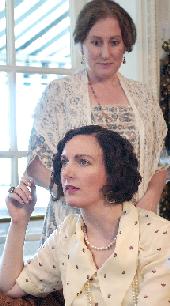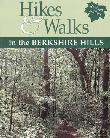SITE GUIDE
SEARCH
REVIEWS
REVIEW ARCHIVES
ADVERTISING AT CURTAINUP
FEATURES
NEWS
Etcetera and
Short Term Listings
LISTINGS
Broadway
Off-Broadway
NYC Restaurants
BOOKS and CDs
OTHER PLACES
Berkshires
London
California
New Jersey
DC
Philadelphia
Elsewhere
QUOTES
TKTS
PLAYWRIGHTS' ALBUMS
LETTERS TO EDITOR
FILM
LINKS
MISCELLANEOUS
Free Updates
Masthead
Writing for Us
A CurtainUp Review
Vita & Virginia<
By Elyse Sommer
|
Vita & Virginia returns for Foliage Season
This play was one of the best offerings of last summer's season. If you missed it and will be in the Berkshires during foliage season, you can catch it between September 24th and October 24th-- again at the Springlawn Theatre and with the same cast, per my review below. Check Shakespeare & Co's box office or website for performance schedule and prices: 413 637-3353; www.shakespeare.org-- ES
|
|
Style is a very simple matter. . . all rhythm. Once you have rhythm, you can't use the wrong word. --- Virginia Woolf, defining good writing. The play about the friendship between these two women is studded with other memorable mots like Virginia's reply to an early letter from Vita: "It brought me a great deal of pain, which I have no doubt is the first stage of intimacy." |

Tod Randolph as Virginia Woolf & Catherine Taylor-Williams as
Vita Sackville-West Photo: Kevin Sprague)
|
Whether you see this play in the morning or evening and whether you've seen it before or not, McCleary's thoughtful direction and the bravura performances of Tod Randolph and Catherine Taylor-Williams, make this one of the theatrical highlights of the Berkshire season.
The chemistry between Randolph (who actually looks a bit like Woolf and has in fact portrayed her in A Room of One's Own, reviewed in the Berkshires and Off-Broadway) and Taylor-Williams is marvelously developed. Taylor-Williams' Vita bursts on stage with explosive energy. She is dashingly stylish and worldly. Randolph's Virginia is older, more sedate, and somewhat frumpy. Bravo to Jennifer Halpern for dressing them so perfectly, right down to Vita's sexy shoes and Virginia's more sensible ones! Of course there's nothing frumpy about Woolf's mind, a fact fully acknowledged by Vita, who in 1922, when the play begins, was actually a more successful writer than the now more widely known and read Woolf. In Vita's own words her writing is part of "a fritter of activity" while her new friend writes books that "occupy a permanent place on the night table with Gerald Hopkins and the Bible." From quoted letters like this, it's clear that for all their differences in style and temperament, there is a strong foundation for a friendship (and love affair), that even after years of being out of touch, has the power to be mutually nourishing during the difficult days of World War II.
For all its atmospheric pleasures, the Spring Lawn Theatre is not a space that lends itself to creative blocking. McCleary nevertheless moves the actresses around without their movements seeming forced or stagey. He has the actors stand more than they sit and at one point he astutely has the energetic Vita climb on a hassock — a nod to the fact that close as the audience is to the actors, the middle rows are not staggered and raised up enough so that when actors sit you often only see the top of their heads (a situation that strikes me as something that should and could easily be remedied). Except for a brief spell early in the second act, McCleary also manages to skirt the risk of stasis common to letter and diary sourced plays. While Vita & Virginia is forged from actual correspondence between Woolf and Sackville-West, Atkins structured her script so that the two women seem to be talking directly to each other and at times literally step from page to stage. This production emphasizes this sense of a living, breathing friendship that happens to be nurtured by written exchanges.
The recent star-studded movie The Hours, based on novelist Michael Cunningham's take-off on Woolf's Mrs. Dalloway, and the filmed version of her ode to Vita, the 1928 novel Orlando and the biography written by Vita's son Nigel about his parents marriage (Portrait Of a Marriage) have all helped to make Virginia and Vita, if not household names, more widely familiar to modern readers and moviegoers. That said, the dialogue is so entertaining, the acting so forceful and the relationship (including the rift caused by Virginia's jealousy of Vita's other lovers) so unambiguous, that you can enjoy the play even if you don't have an in-depth acquaintance with the women's work and lives and if some of the references to famous people who were part of their circle slip past you.
The play is staged with typical Spring Lawn simplicity. Scenic designer Chastity Collins' batik hangings of outdoor scenery — some free-floating over the central playing area, some mounted on the wall — add a subtle and meaningful element. Their style not only reflects the women's love of nature but is similar to the work of Virginia's sister, the painter Vanessa Bell. The hangings take on additional meaning in the second act when Vita describes her journeys through America with her husband Harold Nicholson, when the room shakes with the rumble of bombs being dropped on England, and most strikingly, to depict Virginia's suicide.
Atkins astutely harvested the Woolf/Sackville-West correspondence and diaries so that the written words come alive as real conversations between two deeply connected individuals. I think she would be pleased with this production. Leaving the Spring Lawn Theatre after my own summer morning with these two dynamicd women, I was struck by the aptness of Vita's rhymed translation of Orlando:
"Let us go, then, exploring
This summer morning."
| VITA & VIRGINIA Adapted from the correspondence of Virginia Woolf and Vita Sackville-West by Eileen Atkins Directed by Dan McCleary Cast: Tod Randolph and Catherine Taylor-Williams Costume Design: Jennifer Halpern Lighting Design: Nathan Towne-Smith Scenic Design: Chastity Collins Sound Designer: Jason Fitzgerald Theatre: Spring Lawn Theatre, Kemble Street, Lenox, MA, 413 637-3353; www.shakespeare.org 7/12/03-8/31/03; opening 7/19/03 Tuesday-Thursday at 8:00 pm and on weekend mornings at 10:30. Tickets: $27-$34 with reserved seating; Student, Senior, Group Rates, Rush Tix available. Wheelchair accessible. |

Retold by Tina Packer of Shakespeare & Co.
Click image to buy.
Our Review

Berkshire Hikes &
The Berkshire Book

6,500 Comparative Phrases including 800 Shakespearean Metaphors by CurtainUp's editor.
Click image to buy.
Go here for details and larger image.

